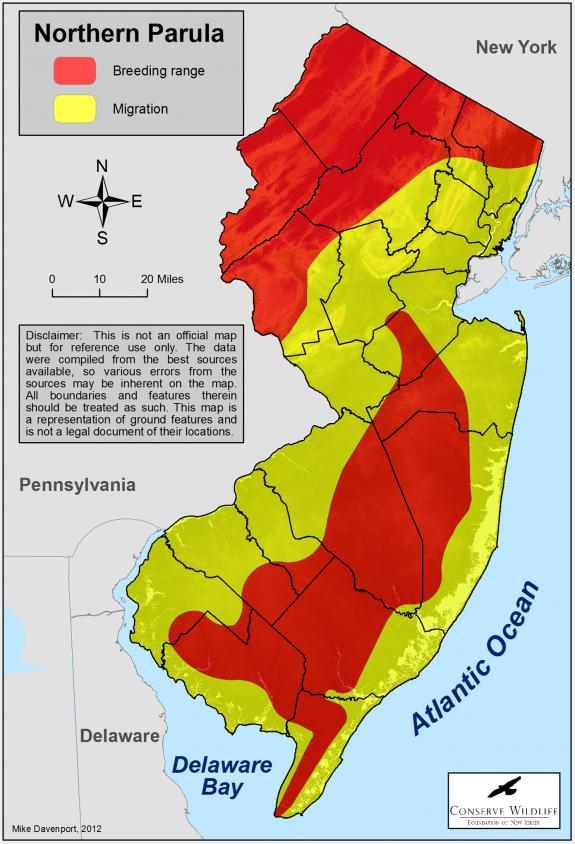Parula americana
Type: bird
Status: special concern
Species Guide
Northern parula
Parula americana
Species Type: bird
Conservation Status: special concern
IDENTIFICATION
The northern parula is New Jersey’s smallest warbler. It is a small migratory songbird about 4 ½ inches in length. Both sexes are bluish with a yellow throat and breast, white belly, two white wing bars, and a small green patch on the back. The male has a small dark band across the breast bordered by a small faint orange or rufous area.

Distribution & Habitat
The breeding range of the northern parula extends throughout much of the eastern half of the US, as far west as Texas, and includes southeastern Canada from Manitoba to Nova Scotia. It winters in the West Indies, northern Central America, and eastern Mexico.
Breeding habitat includes open deciduous, coniferous, or mixed forests near water and where mosses and lichens are abundant. It prefers mature forests but will also occur in young deciduous woodlands. During the winter, they are more of a habitat generalist and may occur in tropical lowland evergreen forest, pine-oak forest, scrub and brushy areas, woodland edges, croplands, and mangroves.
Diet
Northern parulas feed on spiders and insects, such as beetles and caterpillars. In winter, they may also feed on berries, seeds, and nectar.
Life Cycle
The breeding season for the northern parula in New Jersey is between mid-May and early to mid-August. Nests are constructed out of mosses and lichens, usually at the end of a branch about 5 to over 60 feet above the ground and near water. Between 3 to 5 eggs are laid and incubation by the female lasts about 12 to 14 days. The young are tended to by both parents although most feeding is done by the female. The young leave the nest 10 to 11 days after hatching but it takes several more days before they are able to fly. There is a single brood during the breeding season.
Current Threats, Status, and Conservation
The northern parula’s population has undergone a decline in recent years. Such a decline may be due to habitat loss within their breeding range or lack of nesting material. Ideal northern parula habitat contains plentiful supplies of mosses or lichens for nesting material. Declines of moss or lichen due to air pollution, acid rain, or other factors have been documented in the northeastern US and may cause further declines in parula populations. It is listed as a Species of Special Concern in New Jersey (not yet endangered or threatened but possibly on its way).
References
Text written by Michael J. Davenport in 2011.
Scientific Classification
- Kingdom: Animalia
- Phylum: Chordata
- Class: Aves
- Order: Passeriformes
- Family: Parulidae
- Genus: Parula
- Species: P. americana